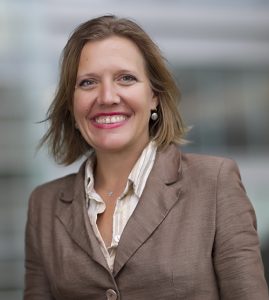Jennifer S. Smith, PhD, at the UNC Gillings School of Global Public Health, UNC School of Medicine, and UNC Lineberger Comprehensive Cancer Center, led the phase 3 controlled trial, which showed that self-collection kits and scheduling assistance are key for reaching these populations and preventing cervical cancer.

CHAPEL HILL, N.C. – Five years ago, the World Health Organization (WHO) announced a global call to eliminate cervical cancer. Because nearly all cervical cancers are caused by an initial infection with oncogenic types of human papillomavirus (HPV), screening for the virus is critical to preventing and treating the disease.
However, providing HPV screening only within clinical settings may limit access to screening for many under-served women across the United States and here, in North Carolina.
Jennifer S. Smith, PhD, and other researchers at the UNC Gillings School of Global Public Health and UNC School of Medicine, conducted an open-label, two-arm randomized controlled trial called “My Body, My Test-3” to see if under-screened, under-served women across North Carolina were more likely to undergo cervical cancer when mailed HPV self-collection kits and offered scheduling assistance.
Researchers found mailed HPV self-collection with scheduling assistance led to more cervical cancer screenings than scheduling assistance alone. The results from the “My Body, My Test-3” study were published in The Lancet Public Health.

“We showed that under-screened women were able to take the time to complete an HPV self-collection kit, return it successfully, found the process acceptable, and that it actually led to their re-engagement in cervical cancer screening,” said Smith, who is a professor in the Department of Epidemiology. “Our study was particularly unique because we used two levels of intervention to increase screening uptake.”
HPV is the most common sexually transmitted infection. In most cases, HPV goes away on its own in a few years and does not cause health problems.
But for some, the infection can spur precancerous lesions, or abnormal cell development in the cervix. If doctors know that a patient has HPV-associated cervical lesions, they can act fast to remove the lesions and decrease one’s risk of developing cervical cancer.
The biggest risk factor for cervical cancer, according to Smith, is being overdue for cervical cancer screening, which is higher among those without medical insurance or the financial stability to cover tests or in-person clinical visit costs.
“Many of the cervical cancer cases in the United States are occurring among women who haven’t been screened regularly, or at all, because of lack of insurance, barriers to transportation, or a lack of knowledge about state-wide screening programs that offer screening free of charge or at a sliding scale,” said Smith.
Mailing self-collection kits helps to break down these access barriers. The technique uses a simple collection device, such as a brush or swab, to obtain cervico-vaginal cell samples to test for HPV infection. The HPV test itself has comparable performance to physician-collection for the detection of high-grade cervical precancerous lesions or cancer.
One of the advantages of self-collection is that it eliminates the need for an initial in-clinic pelvic examination and can be performed at home, or another location that is convenient for the patient. Those with positive HPV results are then referred to follow-up care at the clinic.
As part of the trial, 665 women were contacted and helped with booking a screening appointment at a nearby clinic. One group of the women were only offered scheduling assistance, so researchers could determine if the intervention was successful on its own.
The remaining group of the women also received an HPV self-collection kit with illustrated instructions and a self-collection brush. They were given a pre-stamped envelope to send back their samples for laboratory testing.
The idea of self-collection is not a new one. Self-collection is being used in national programs throughout the globe already, such as in Denmark and the Netherlands. But self-collection in the United States is still in under review with the Food and Drug Administration (FDA).
The researchers hope the evidence from the trial will help provide some extra momentum for the FDA’s approval of HPV self-collection. If self-collection is approved by national screening bodies, programs, community organizations such as Medicaid, Federally Qualified Health Centers, or the Breast and Cervical Cancer Control Program, it could be used to identify under-screened people and implement HPV self-collection by mail or within the clinical setting.
For Smith, the trial was incredibly valuable in that it served as a challenging learning experience on ways to reach women overdue for cervical cancer screening. They used a variety of community-outreach methods to recruit women for the screening trial, including through social media, radio, and flyers on local buses.
Inevitably, Smith says that it is important for doctors, researchers, and programs to find interventions and screening strategies that cater to the women who need to be screened.
“We won’t make an impact on reducing cervical cancer in North Carolina, or globally, until we are able to find the women who aren’t being screened and ensure that they get screening,” said Smith. “We need to work together with them. Our results showed that mailing HPV self-collection kits to women who had not been screened regularly doubled cervical cancer screening uptake.”
Moving forward, the researchers will be thinking about the best approaches to providing HPV self-collection outreach. For example, patients could be flagging through medical records as being overdue for screening, and kits could be delivered through the mail or offered in person as they come into the clinic for other services.
Smith believes that as more programs consider integrated self-collection as part of patient care, it is critical to consider the entire cervical cancer cascade, from increasing screening access to providing the needed follow-up care if a self-test result is positive.
“It is important to ensure that women can have access to providers if they have questions about the self-collection process or their results,” said Smith. “If they have a positive self-test result, they need to be ensured the appropriate follow-up care for good patient care.”
Other authors on the Lancet Public Health paper are Peyton K. Pretsch, MPH, Lisa P. Spees, PhD, Noel Brewer, PhD, Michael G. Hudgens, PhD, Busola Sanusi, MA, Eliane Rohner, PhD, Elyse Miller, MPH, Sarah L. Jackson, MPH, and Stephanie B. Wheeler, PhD, MPH, UNC; Lynn Barclay, American Sexual Health Association, Research Triangle Park, NC; and Alicia Carter, MD, Laboratory Corporation of America Holdings, Burlington, NC.
Media contact: Kendall Daniels, Communications Specialist, UNC Health | UNC School of Medicine